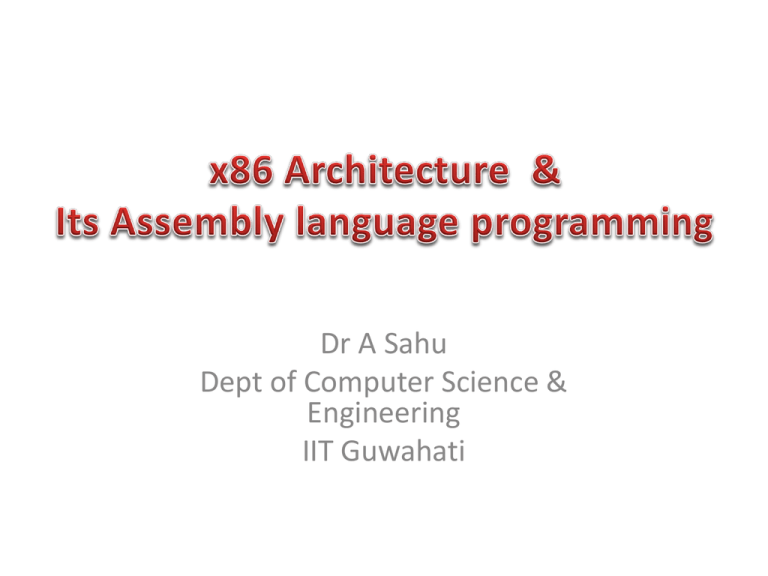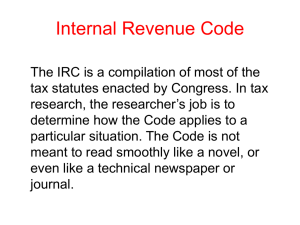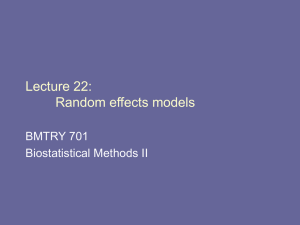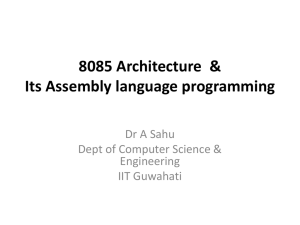PPTX Slides
advertisement

Dr A Sahu
Dept of Computer Science &
Engineering
IIT Guwahati
• Review of 8086 Architecture
– Block diagram (Data Path)
• Similarity with x86 (i386, Pentium, etc)
– Very IMP for interview/knowledge
– Not part of Examination
• x86 Assembly language program
–
–
–
–
Memory model
Example programs
Data Segment
Loop and Nested Loop
• Next Class: Detail of assembly language
– Summary of 8085/8086/i386 Arch & programming
• 16 bit Microprocessor
• All internal registers as well as internal and
external data buses were 16 bits wide
• 4 Main Register, 4 Index Register, 4 Segment
Register, Status Reg, Instr Ptr.
• Not compatible with 8085, but with successors
• Two Unit works in parallel:
– Bus Interface Unit (BIU)
– Execution Unit (EI)
Bus Interface
Unit
C BUS
Q6
Q5
Q4
Q3
Q2
Q1
SUM
CS (Code Seg Reg)
DS (Data Seg Reg )
ES (Extra Seg Reg )
SS (Stack Seg Reg)
IP (Intr Ptr)
Operand
InDirect
Execution
Unit
AH
BH
CH
DH
Sequencer
A BUS
SI (Source Idx )
DI (Dest. Idx)
BP (Base Ptr )
SP (Stack Ptr)
Z (Flag Reg)
AL
BL
CL
DL
Temp A
Temp B
Temp C
ALU
• Execution Unit :
– ALU may be loaded from three temp registers (TMPA, TMPB,
TMPC)
– Execute operations on bytes or 16-bit words.
– The result stored into temp reg or registers connected to the
internal data bus.
• Bus Interface Unit
–
–
–
–
–
–
–
–
BIU is intended to compute the addresses.
Two temporary registers
indirect addressing
four segment registers (DS, CS, SS and ES),
Program counter (IP - Instruction Pointer),
A 6-byte Queue Buffer to store the pre-fetched opcodes and data.
This Prefetch Queue optimize the bus usage.
To execute a jump instruction the queue has to be flushed since the
pre-fetched instructions do not have to be executed.
• 1978: 8086 (16 bit architecture)
• 1980: 8087
• Floating point coprocessor is added
• 1982: 80286
• Increases address space to 24 bits
• 1985: 80386:
• 32 bits Add,
• Virtual Mem & new add modes
• Protected mode (OS support)
• 1989-95: 80486/Pentium/Pro
• Added a few instructions of base MMX
• 1997: Pentium II
• 57 new “MMX” instructions are added,
• 1999: Pentium III:
• Out of Order, added another 70 Streaming SIMD Ext (SSE)
• 2001: Pentium 4
• Net burst, another 144 instructions (SSE2)
• 2003: PI4 HT, Trace Cache
• 2005: Centrino, low power
• 2007: Core architecture, Duo
• 2008: Atom, Quad core with HT….
• 2009---:Multi core (Large chip multiprocessor)
IF
D
IS
EX
WB
How Complex
the HW will be
Time in base Cycle
0
1
2
3
4
5
6
7
8
9
Fetch
Decode
Unit
& issue
Cache/
memory
Multiple instruction
FU
FU
Sequential stream of instructions
Instruction/control
Data
FU
Funtional Unit
Register file
FU
Pipeline
Instruction 1
Pipe 1
Instruction 2
Decoder
EX Unit
WB Unit
Instruction 3
Instruction 4
Pipe 2
• Used in initial Pentium processor
• Could execute up to 2 instructions simultaneously
• Instructions sent through the pipeline in order - if the next
two instructions had a dependency issue, only one
instruction (pipe) would be executed and the second
execution unit (pipe) went unused for that clock cycle.
Instruction 1
Instruction 2
Instruction 3
Instruction 4
Pipeline
Decoder
Decoder
Decoder
Out of Order EU
Scheduler
EX Unit
WB Unit
Re Order
Buffer
• Used in the Pentium II, III and Pro processors
• 3 instruction decoders, which break each CISC instruction
(macro-op) into equivalent micro-operations (µops) for
the Out-of-Order Execution unit
• 10 stage instruction pipeline utilized in this architecture
Pipeline
Out of Order EU
Instruction 1
Instruction 2
Instruction 3
Instruction 4
Decoder
Decoder
Decoder
Decoded
Instructions
(Execution
Trace Cache)
Scheduler
EX Unit
Re Order
Buffer
WB Unit
• New architecture used for the Intel Pentium IV
and Pentium Xeon processors
Parallel
decoding
and issue
Parallel
instruction
execution
Preserving the
sequential
consistency of
instruction execution
and
exception processing
I - cache
I - cache
Instruction
buffer
Instruction
buffer
Scalar
Issue
IF
Decode & Issue
D/I
Superscalar
Issue
Decode & Issue
IF
IF
IF
D
D
D
I
I
I
• Fetch multiple instructions in instruction
buffer
• Decode multiple instructions in parallel –
instruction window
• Possibly check dependencies among these
as well as with the instructions already
under execution
•
•
•
•
ADD
ADD
LD
ST
T
W
A,
C,
A B
C D
0(W)
0(B)
T= A+B
W= C+D
A=M[W]
M[B]=C
Read After Write (RAW), W after W, W after R
RAW (Ins2-Ins3): True dependency
WAW, WAR (Ins1 ot Ins3) : false dependency
Blocking Issue
• Decode and issue to EU
Instructions may be
blocked due to data
dependency
Non-blocking Issue
• Decode and issue to
buffer
• From buffer dispatch to
EU
Instructions are not
blocked due to data
dependency
Instruction
Buffer
issue window
Decode
Check & Issue
EU
EU
EU
Instruction
buffer
Decode & Issue
Reservation
station
Reservation
station
Dep. Checking/
dispatch
EU
Reservation
station
Dep. Checking/
dispatch
EU
Dep. Checking/
dispatch
EU
Preserving issue order
in-order out of order
Alignment of instruction issue
aligned
unaligned
•
•
•
•
ADD
ADD
LD
ST
T
W
A,
C,
A B
C D
0(W)
0(B)
T= A+B
W= C+D
A=M[W]
M[B]=C
Issue in strict program order
Instructions
to be issued e
Instructions
issued
Out of order Issue
Issue window
d
c
b
a
Instructions
to be issued e
a
Instructions
issued
Issue window
d
c
b
a
c
a
Example: MC 88110, PowerPC 601
Independent instruction
Dependent instruction
Issued instruction
Aligned Issue
checked
in cycle 1
Unaligned Issue
next window
fixed window
h
d
g
f
e
c
b
issued
in cycle 1
checked
in cycle 2
issued
in cycle 3
h
g
f
e
d
c
b
a
h
g
f
e
d
issued
in cycle 2
checked
in cycle 3
a
gliding window
c
b
c
h
g
f
e
a
h
g
f
e
d
b
d
h
d
a
g
f
e
d
f
e
d
c
b
c
b
Coping with
Coping with
false data
unresolved
dependencies
control
dependencies
Use of
shelving
blocking
no
Register
renaming
wait speculative
Handling of
issue blockages
shelved
Issue
rate
(2-6)
Type of the
shelving buffers
Stand
alone
(RS)
combined with
renaming and
reordering
Number of
shelving buffer entries
individual 2-4
group 6-16
central 20
total 15-40
Number of read
and write ports
depends on
no. of EUs
connected
Individual RSs
RS
EU
Group RSs
RS
EU
RS
EU
Central RS
RS
EU
EU
RS
EU
EU
EU
Decode/issue
instruction
data
RF
RS
EU
RS
EU
RS
EU
RS
EU
instruction
data
Decode/issue
RS
RS
RS
RS
RF
EU
EU
EU
EU
• Register Renaming
– Removes false dependencies (WAR and WAW)
• Reordering Buffer (ROB) : Pentitum Out of
order instruction processing
– Ensures sequential consistency of interrupts
(precise vs imprecise interrupts)
– Facilitates speculative execution
• Branch execution
• Execute both path and discard after getting CC
Value
write
IF
IS
read
IF
IS
write
IF
IS
DP EX
WB
WAW
DP EX
RAW
DP EX
WB
WAR
WB
write R5
write R5
RAW
read R5
RAW
read R5
WAR
write R5
write R8
RAW
read R5
RAW
read R8
• Compiler
– Done statically
– Limited by registers visible to compiler
• Hardware
– Done dynamically
– Limited by registers available to hardware
• Kernel code writing
–
–
–
–
Process switching code
Thread synchronization code
Lock, barrier (test & set, fetch & increment, xcng)
pthread spin_lock (in ASM) is 28% faster than intel
tbb::spin_mutex (in C)
• Time critical coding (Coding for DSP)
– /usr/include/asm-i386
• Use of MASM/TASM/GCC/NASM compiler
– gcc –S test.c –o test.s
• C/C++ code with asm block
• 8086 compatible with ii386/pentium
•
•
•
•
AX - the accumulator register (divided into AH / AL)
BX - the base address register (divided into BH / BL)
CX - the count register (divided into CH / CL)
DX - the data register (divided into DH / DL)
•
•
•
•
SI - source index register.
DI - destination index register.
BP - base pointer.
SP - stack pointer.
AH
AL
BH
BL
CH
CL
DH
DL
SI (Source Idx )
DI (Dest. Idx)
BP (Base Ptr )
SP (Stack Ptr)
Z (Flag Reg)
CS (Code Seg Reg)
DS (Data Seg Reg )
ES (Extra Seg Reg )
SS (Stack Seg Reg)
IP (Intr Ptr)
31
15
7
EAX
EBX
ECX
EDX
ESI
EDI
EBP
ESP
AH
AL
BH
BL
CH
CL
DH
DL
SI (Source Idx )
DI (Dest. Idx)
BP (Base Ptr )
SP (Stack Ptr)
EZ
Z (Flag Reg)
ECS
EDS
EES
ESS
CS (Code Seg Reg)
DS (Data Seg Reg )
ES (Extra Seg Reg )
SS (Stack Seg Reg)
EIP
IP (Intr Ptr)
0
Extended
• Stack
– automatic (default), local
– Initialized/uninitialized
Stack
• Data
– Global, static, extern
– BSS: Block Started by Symbol
– BBS: Uninitialized Data Seg.
• Code
– program instructions
Heap
BSS
Data
• Heap
– malloc, calloc
Code
int A;
int B=10;
main(){
int Alocal;
int *p;
p=(int*)malloc(10);
}
Stack
Heap
BSS
Data
Code
.model small
.stack 100h ; reserve 256 bytes of stack space
.data
message db "Hello world, I'm learning Assembly$”
.code
main proc
mov ax, seg message
mov ds, ax
mov ah, 09 // 9 in the AH reg indicates Procedure
//should write a bit-string to the screen.
lea dx, message // Load Eff Address
int 21h
mov ax,4c00h // Halt for DOS routine (Exit Program)
int 21h
main endp
end main
• .model small
– Most widely used memory model.
– The code must fit in 64k.
– The data must fit in 64k.
• .model medium
– The code can exceed 64k.
– The data must fit in 64k.
• .model compact
– The code must fit in 64k.
– The data can exceed 64k.
• .medium and .compact are opposites.
• db : define byte
• dd: def double word (4)
• equ : equate assign numeric
dw: def. word (2 bytes)
dq : def quad word (8)
expr to a name
.data
db A 100 dup (?) ; define 100 bytes, with no initial
values for bytes
db “Hello” ; define 5 bytes, ASCII equivalent of “Hello”.
dd PtrArray 4 dup (?)
;array[0..3] of dword
maxint equ 32767 ; define maxint=32767
count equ
10 * 20
; calculate a value (200)
• Assemby code: Loop
– Loop simply decreases CX and checks if CX != 0, if
so, a Jump to the specified memory location
MOV CX,100
_LABEL: INC AX
LOOP _LABEL
– LOOPNZ : LOOPs when the zero flag is not set
MOV CX,10
_CMPLOOP: DEC AX
CMP AX,3
LOOPNE CMPLOOP
• Assemby code: Nested Loop: One CX register
mov cx, 8
Loop1: push cx
mov cx, 4
Loop2: stmts
loop Loop2
pop cx
stmts
loop Loop1
•
•
•
•
•
Detail of Assembly language program
Addressing mode
Example program
Assignment problem
Summary of 8085/8085/i386 Arch &
programming (1st Unit of Syllabus)
• Introduction to device interfacing
– Device type
– Interfacing









